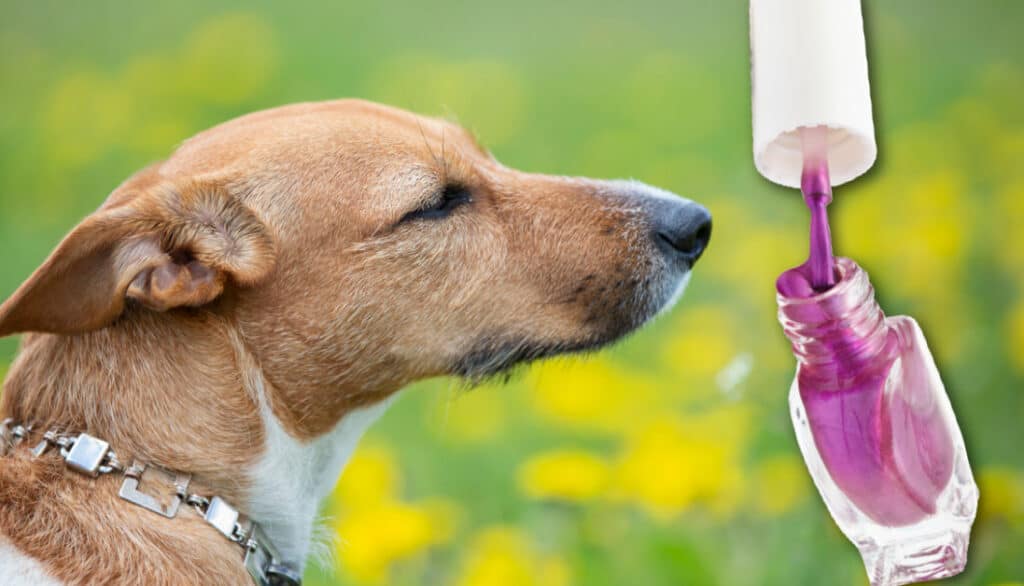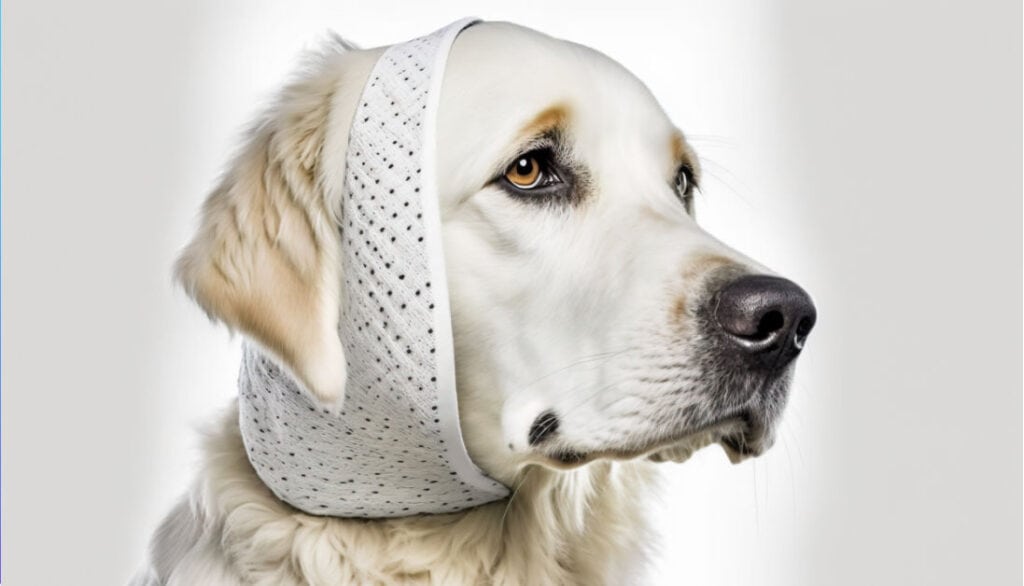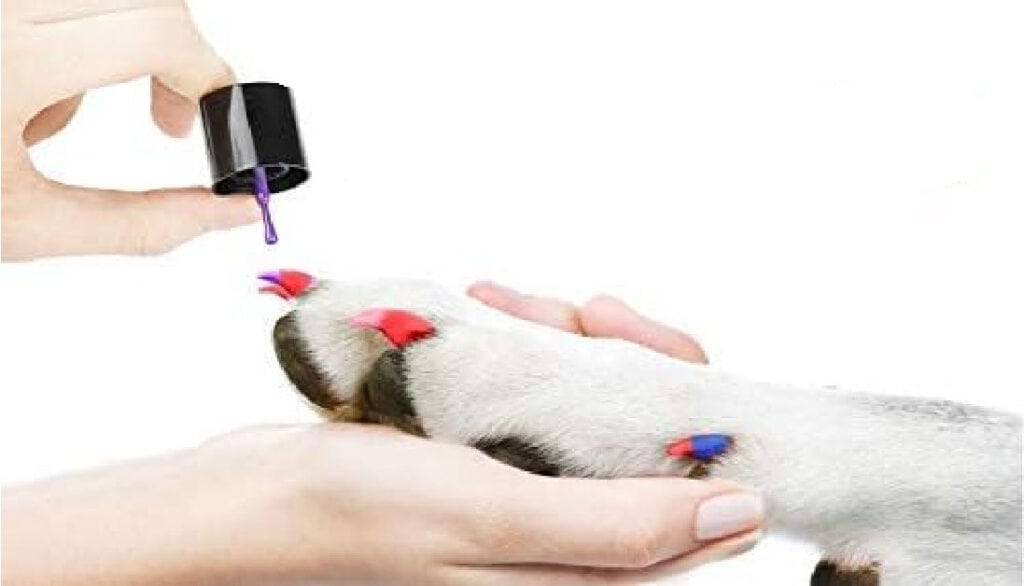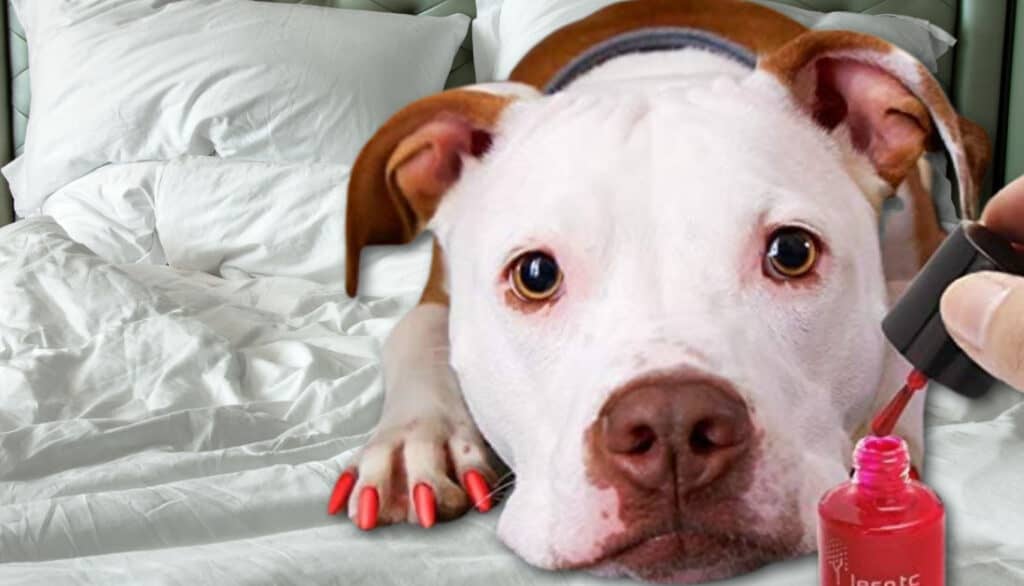In a world where our fur-babies are increasingly becoming part of our fashion-forward adventures, it’s tempting to incorporate them into every aspect of our style narratives. From chic dog sweaters to sparkly collars, our dogs are looking more fabulous than ever. Lately, there’s been a growing trend of dog owners applying nail polish to their pets’ claws, aiming to give them that extra touch of glam. But before we dip our pooches into the world of manicures, it’s crucial to address an essential question: Is nail polish safe for dogs? The short answer is no, human nail polish is toxic to dogs.
While their wagging tails might make you think they’re just as excited about a fresh coat of polish as you are, the reality might be a tad more complicated. The myriad ingredients found in our favorite nail polishes might not be as canine-friendly as we’d hope. This blog aims to provide you with an in-depth look into the potential risks, the signs of nail polish poisoning in dogs, and safer alternatives to ensure your furry friend remains both stylish and healthy. Let’s dive into the world of canine cosmetic conundrums and clear the air.

Human Nail Polish on Dogs: Is It Safe?
Grooming and dressing up pets has been an age-old tradition, often reflecting the owner’s personal style or the prevailing fashion trends. Recently, nail polish for dogs has gained traction, but many have started wondering about the safety of using regular, human nail polish on their four-legged companions.
Why the Concern?
The skin and nails of dogs are quite different from ours. Their nails, unlike human nails, are more porous, which means substances applied to them might get absorbed into their system more readily than one would expect. This makes the choice of nail polish particularly critical.
Key Ingredients in Human Nail Polish:
Many human nail polishes are formulated with a myriad of chemicals designed to enhance the polish’s quality, longevity, and shine. While these chemicals might not always pose a significant risk to humans, they can be potentially harmful to dogs. Here are some of the most common, potentially hazardous ingredients:
- Toluene:
- What is it? A solvent that helps give nail polish a smooth finish.
- Why is it harmful? Toluene can cause nervous system disorders when inhaled or absorbed in significant amounts. For dogs, whose noses are incredibly sensitive, even small amounts can be harmful.
- Formaldehyde:
- What is it? A hardening agent that helps nail polish resist chipping.
- Why is it harmful? Formaldehyde is a known carcinogen, and while humans may not face an immediate risk from the small amounts in nail polish, the story might be different for our smaller furry friends. Prolonged exposure can lead to respiratory issues and more.
- Dibutyl Phthalate (DBP):
- What is it? A plasticizer that provides flexibility to the nail polish, preventing cracks.
- Why is it harmful? DBP has been linked to reproductive issues in larger animals and could potentially be harmful to dogs, especially when ingested.

Beyond the Ingredients:
It’s also worth noting that while we can explain to humans the need to avoid touching or licking freshly painted nails, the same isn’t true for dogs. Their natural inclination is to nibble, lick, or chew, especially if something new or unusual is on their body. This behavior significantly increases the risk of them ingesting harmful chemicals.
Moreover, the strong smell of nail polish can be overwhelming for dogs. With their enhanced sense of smell, what seems like a slight odor to us can be unbearable for them.
Conclusion on Safety:
While dressing up your dog and having them sport colorful nails can be an appealing idea, using human nail polish may not be the safest choice. The potential health risks posed by the chemicals present in these polishes, combined with a dog’s natural behaviors, make it a risky endeavor.
For those still keen on giving their dogs a manicure, it’s recommended to look into dog-specific nail polishes, which are formulated with pet safety in mind. They’re free from harmful chemicals and are designed to be safe even if ingested in small amounts.

Is Nail Polish Bad for Dogs to Smell?
Our canine companions have an extraordinary sense of smell. While this heightened sense can be a blessing, especially when they’re detecting treats or identifying familiar scents, it can also be a curse when confronted with strong and potentially harmful odors.
The Olfactory Power of Dogs:
Dogs possess up to 300 million olfactory receptors in their noses, in contrast to about 6 million in humans. Furthermore, the part of a dog’s brain that analyzes smells is 40 times greater than ours. This means what might be a faint aroma to us could be overpowering for a dog.
Nail Polish and Its Fumes:
When we paint our nails, or when we open a bottle of nail polish, volatile organic compounds (VOCs) are released into the air. These compounds, like toluene and formaldehyde, are responsible for that strong, chemical smell typical of many nail polishes.
How Can This Affect Dogs?
- Immediate Irritation: For dogs, inhaling these potent fumes can lead to immediate discomfort. It can cause irritation in their eyes, nose, and throat. You might notice your dog sneezing, coughing, or trying to move away from the smell.
- Respiratory Issues: If a dog is exposed to these fumes for an extended period, it can result in respiratory distress. It’s similar to how humans might feel in a room with poor ventilation and strong paint fumes.
- Behavioral Changes: Dogs might become anxious or stressed due to the strong smell. They could try to hide, become agitated, or display signs of discomfort.
- Nausea and Headaches: Just like humans can get headaches from strong scents, dogs can also experience similar symptoms, leading to reduced appetite or lethargy.

Precautions for Using Nail Polish Around Dogs:
- Ventilation: If you’re painting your nails in the same space as your dog, ensure the room is well-ventilated. Open windows or use fans to dissipate the strong fumes.
- Distance: Keep your dog in another room while you’re applying nail polish. Once the polish is dry and the smell is minimized, you can bring your dog back.
- Use Pet-Safe Polishes: If you’re painting your dog’s nails, always use polishes formulated specifically for pets. These are usually water-based, non-toxic, and have a milder odor.
While the occasional whiff of nail polish might not be lethal for dogs, the strong odors can be very uncomfortable for them. As a responsible pet owner, it’s essential to be aware of the potential discomfort and risks posed by nail polish fumes and take appropriate precautions to ensure your dog’s well-being.

Symptoms of Nail Polish Poisoning in Dogs
When a dog comes into contact with or ingests human nail polish, it can lead to poisoning due to the toxic chemicals present. Recognizing the signs early can make a significant difference in how your pet recovers.
1. Gastrointestinal Symptoms:
If your dog licks or ingests nail polish, some immediate symptoms might manifest in the digestive system:
- Vomiting: This can sometimes include blood.
- Diarrhea: The stools might be darker than usual or even have a tarry appearance.
- Loss of Appetite: Your dog may show reluctance to eat.
2. Neurological Symptoms:
The chemicals, especially toluene and formaldehyde, can affect the nervous system:
- Dizziness or Lack of Coordination: Your dog might stumble or seem disoriented.
- Lethargy or Weakness: A marked decrease in energy levels.
- Tremors or Seizures: In severe cases, uncontrollable shaking or full-blown seizures can occur.
3. Respiratory Symptoms:
Inhalation of the fumes or direct contact with the polish can affect the respiratory system:
- Coughing and Sneezing: As a result of irritation.
- Difficulty Breathing: Rapid or shallow breaths.
- Increased Heart Rate: A noticeable increase in their heartbeat.

4. Dermatological Symptoms:
If the nail polish comes into contact with their skin or fur:
- Redness or Irritation: Especially around the mouth, nose, or paws.
- Swelling: Particularly in areas where the nail polish might have spilled.
- Excessive Itching or Scratching: Your dog might try to lick or scratch the affected area continuously.
5. Behavioral Changes:
- Anxiety or Agitation: Your dog might become more restless than usual.
- Depression: In contrast, they might also display signs of depression or disinterest in their surroundings.
6. Other Symptoms:
- Excessive Drooling or Salivation: A common reaction to something irritating or harmful.
- Abdominal Pain: Your dog might whine or seem uncomfortable, especially when their belly is touched.
- Change in Urine Color: In severe cases, the chemicals can affect kidney function leading to darker or blood-tinged urine.
If you observe any of these symptoms in your dog, especially after they’ve been around nail polish, it’s crucial to take immediate action. Contact your vet or an emergency animal clinic right away. Even if the symptoms seem mild, it’s always better to err on the side of caution.
Remember, prevention is always better than cure. Ensure your nail polish and remover are stored safely out of reach of your pets and avoid using them in close proximity to your dogs without adequate ventilation.

What To Do if Your Dog Ingests Human Nail Polish
Ingesting nail polish can be harmful to dogs due to the potentially toxic chemicals they contain. Quick and appropriate actions can make a significant difference in the outcome for your pet.
1. Call or Visit Your Trusted Veterinarian:
- Immediately contact your veterinarian or an emergency animal clinic. Describe the situation accurately, including the type and amount of nail polish ingested, if possible.
- If you can, take the nail polish bottle with you. This can help the vet determine the ingredients and the best treatment method.
2. Keep a Watchful Eye on Your Dog:
- Monitor your dog closely for any symptoms of poisoning such as vomiting, lethargy, difficulty breathing, or seizures.
- Even if they seem fine initially, symptoms can manifest hours after ingestion.
3. Give Your Dog a Bath:
- If there’s nail polish on their fur, especially around the mouth or paws, gently wash it off using dog-safe shampoo. This can prevent further ingestion if they lick themselves.
- Ensure you rinse thoroughly to remove all residues.
4. Do Not Panic:
- While it’s natural to be worried, staying calm is vital. Your dog will pick up on your emotions, and if you’re panicking, it may make them more anxious.
- Focus on getting them the help they need promptly.

What Not To Do:
1. Do Not Induce Vomiting:
- Unless specifically instructed by a veterinarian, do not try to make your dog vomit. Some substances can cause more harm if vomited, especially if they’re corrosive or cause burns.
2. Refrain from Home Remedies:
- While the internet is full of home remedies for various ailments, this is not the time to experiment. Incorrect treatments can exacerbate the situation.
The ingestion of human nail polish by dogs is a serious concern. If faced with this situation, prompt and appropriate actions can make all the difference. Always prioritize seeking professional medical advice and care for your pet in emergencies.
Remember, prevention is essential. Store nail polish and other potentially toxic substances in a location that’s inaccessible to your pets. Your furry friend’s safety and well-being should always be the top priority.

How to Safely Remove Polish
1. Use Pet-Safe Nail Polish Remover:
- Always opt for a nail polish remover that is formulated specifically for pets. These removers are typically non-toxic and free from harmful chemicals found in regular removers.
- Avoid removers containing acetone, as it can be harsh on your dog’s nails and skin.
2. Prepare Your Dog:
- Choose a quiet, well-lit area.
- Ensure your dog is calm. You can use treats or toys as distractions.
- If your dog is nervous or anxious, consider seeking help from another person to hold and comfort them.
3. Gentle Application:
- Using a soft cotton ball or pad, apply a small amount of the pet-safe nail polish remover.
- Gently press the soaked cotton ball against the nail for a few seconds, and then softly rub the nail until the polish starts to come off.
- Be cautious not to rub too hard as you could damage the nail or irritate the surrounding skin.
4. Rinse the Paws:
- Once you’ve removed the polish, wash your dog’s paws with mild pet-friendly soap and lukewarm water to remove any residue.
- Dry the paws thoroughly with a soft towel.
5. Check for Irritation:
- After the polish is removed, inspect your dog’s nails and the surrounding skin for any signs of redness or irritation.
- If you notice any irritation, avoid applying any new polish for some time and consult with your vet if the irritation persists.
6. Moisturize:
- Dog nails and the surrounding skin can become dry after using polish or polish removers. Consider using a pet-friendly moisturizer or paw balm to hydrate and protect the area.
7. Store Products Safely:
- Ensure that all nail products, including removers, are stored in a place inaccessible to pets to prevent accidental ingestion or exposure.

Doggie Nail Polish: A Safer Alternative to Human Nail Polish
1. Formulated for Pets:
- Non-toxic Ingredients: Doggie nail polishes are specifically designed to be non-toxic and safe for pets. They do not contain harmful chemicals such as toluene, formaldehyde, and dibutyl phthalate, which are often found in human nail polishes.
- Quick Drying: Many pet nail polishes are quick-drying, reducing the risk of smudges and the time your dog needs to stay still.
2. Milder Odor:
- Unlike regular nail polishes that emit strong, chemical smells, dog nail polishes often have a milder odor. This is particularly beneficial given dogs’ sensitive sense of smell.
3. Easier to Remove:
- Doggie nail polishes are often formulated to be easily removable, requiring less aggressive solvents than those needed for human nail polishes. Some can even peel off without the need for any remover.
4. Comes in Various Colors and Styles:
- From glittery finishes to glow-in-the-dark, there’s a wide array of colors and styles available. This allows pet owners to get creative and have fun while ensuring their pet’s safety.
5. Considerations for Application:
- While doggie nail polishes are safer, it’s essential to ensure your dog is comfortable during the application. Always pick a calm environment, reward them with treats, and never force the process if they’re too anxious.
- Before applying any nail polish, even those formulated for dogs, always do a patch test to ensure there’s no allergic reaction.
6. Buying Tips:
- Read Labels: Always check the label to ensure that the product is truly non-toxic and free from harmful chemicals.
- Reviews & Recommendations: Check for reviews or ask other pet owners or your vet for recommendations on trusted brands.
- Water-Based: Opt for water-based formulas. They’re typically safer, easier to remove, and less likely to cause any adverse reactions.

How to Apply Dog Nail Polish
Applying nail polish on dogs is a fun activity, but it’s essential to approach it with care to ensure your dog’s safety and comfort. Here’s a step-by-step guide to applying dog nail polish:
1. Choose the Right Product:
- Pet-Specific: Always opt for nail polishes that are specifically formulated for pets. These polishes are non-toxic and safer for dogs.
- Read Labels: Look for products that are free from harmful chemicals and preferably water-based.
2. Prepare the Nails:
- Trim: If your dog’s nails are long, start by giving them a gentle trim.
- Clean: Make sure the nails are clean and free from dirt. You can use a damp cloth to wipe each nail.
- Dry: Before applying the polish, ensure that the nails are thoroughly dry.
3. Create a Calm Environment:
- Choose a quiet space where your dog feels relaxed.
- You might want to give them a toy or treat to distract and keep them occupied during the process.
4. Application:
- Shake the Bottle: Ensure the polish is well-mixed by shaking the bottle before use.
- Start Small: Begin with one nail to see how your dog reacts. If they’re comfortable, you can proceed.
- Thin Coats: Apply thin coats for quicker drying and a smoother finish. If you want a more vibrant color, wait for the first coat to dry completely before applying another.

5. Drying Time:
- It’s essential to allow the polish to dry thoroughly. This can take anywhere from a few minutes to half an hour, depending on the polish.
- Some pet-specific nail polishes are quick-drying, which can be advantageous.
6. Praise and Reward:
- Throughout the process and after, ensure you praise your dog and perhaps offer a treat. This positive reinforcement can make future applications easier.
7. Removal and Care:
- When it’s time to remove the polish, use a pet-safe nail polish remover. Regular human nail polish removers might contain chemicals that could be harmful to dogs.
Additional Tips
- Always conduct a patch test before full application to check for any allergic reactions.
- If your dog seems distressed or uncomfortable at any point, stop the application and try again another time or skip it altogether.
- Ensure that your dog doesn’t lick or chew their nails immediately after application.

Conclusion
The world of canine cosmetics is an intriguing one. As pet owners, it’s only natural to want to pamper and adorn our furry friends, giving them a dash of style and flair. But with that desire comes the paramount responsibility of ensuring their safety and well-being. This guide has delved deep into the world of nail polishes, illustrating the potential dangers of using human products on our pets and shedding light on safer alternatives.
It’s crucial to remember that while our intentions might stem from love and affection, not all products made for humans are fit for our pets. Their physiology, behavior, and sensitivities are different from ours. Thankfully, the pet industry recognizes the growing desire for pet pampering and has responded with safer, pet-friendly alternatives.
In wrapping up, always be informed, exercise caution, and prioritize your pet’s health above all else. Your canine companion trusts you implicitly, and it’s our duty to ensure that this trust is never broken. So, the next time you’re thinking of a little nail glam for your pup, reach for that pet-friendly polish, apply with love, and watch them strut their stuff, safely and stylishly!
